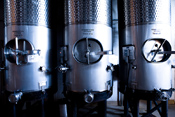
|
|
Automated manufacturing process

There are many automated processes that help to manufacture several products at the same time. This can lead to cheaper product costs for customers but it also allows a company to take on several different projects at the same time. Automated assembly is one of the things that has revolutionized the manufacturing industry but it needs to be the right automated process in order to provide customers with the right products. There are about 4 different types of automated assembly out there that you can choose from. Here are the different manufacturing processes that are available:
|
|
- Single work cell
- Flexible
- Synchronous
- Non-synchronous automation
Most manufacturing plants are able to provide multiple automated manufacturing processes in order to give their customers plenty of options. What is the difference between the multiple automated manufacturing processes? Here is an explanation into the different processes along with what you need to know about them.
Single Work Cell
This is an automated assembly process. What this process will do is perform an entire assembly of work in a single cell, allowing a single product to be created in a timely manner. For a high volume production, single work cell automation is a great way to get the products created quickly.It is common for products that have multiple areas to use this type of manufacturing because each plant will focus on specific aspects of the overall product. Once each part is made, it will then be assembled and finished.
Flexible Manufacturing
With flexible manufacturing it is common to deal with computer-generated and operating systems. It is designed for high output but only for moderately sized batches. It rarely does multiple products at the same time as it is focused on very moderate batches in order to produce the right type of products in a timely manner.
Synchronous Automated Assembly
This is a type of manufacturing system that is automated but it is called in-line or circular. You will usually see a carousel configuration in order to create the products or parts for a completed product. Often they work with other cells to keep the entire manufacturing process moving forward in a continuous pattern and movement. If there is a breakdown, then you have a concern over the manufacturing process as it will shut down the entire assembly line. You will need to fix it and to service the equipment often to be sure that it is able to run correctly.
With this type of set-up you are looking at higher expenses due to the intimate nature of the equipment as it does have a lot of needs. The process will only be able to run as quickly the machines will allow it to. For this reason synchronous automation is not the best for large parts that need to be done in a quick manner. This is the best system for small and lightweight parts as it can handle these smaller needs and not the larger loads.
Non-Synchronous Automation
To have movement in the manufacturing process, this is perhaps one of the best systems to use. It will allow you to use different work cells and to move them quickly through the company, getting the products to the customers in a fast and timely manner. The problem that you may run into is the time it takes for the cells to work with one another. You have so many steps to work with that a single delay in one step will shut down the operation of the entire automated process. Because of the different parts and needs, this type of automation is much slower and not always preferred.
Privacy Policy, Terms of Use